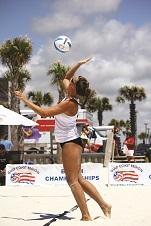
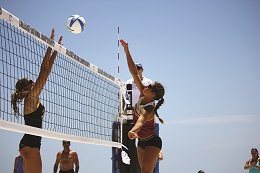
Played on a variety of surfaces and in a wide range of settings, volleyball is experiencing a growth spike many sports only dream about. For example, 36 years ago, when Tom Galecke started the Waupaca Boatride Volleyball Tournament, it was a six- or seven-net grass volleyball tournament in a state park. Afterward, members of the 20 or 30 teams that participated would go paddle boating, and the “Boatride” part of the tournament’s name was born. Today, the tournament draws over 900 teams over three days, with on-site camping and entertainment, and is nicknamed ‘The U.S. Open of Grass Volleyball.’
Similarly, the 1980s and ‘90s saw the meteorical rise of beach, or sand, volleyball—a trend that shows no signs of slowing down. Women’s sand volleyball has been identified by the NCAA as an emerging sport and is only a few teams away from the 40 teams needed to be able to hold an NCAA championship. The list of universities considering adding sand volleyball programs is long.
Indoor volleyball continues to hold strong in terms of participation, meaning the sport is growing on all fronts. Ever more people are playing, and because of the option to play on different surfaces, they are playing with different skill sets, at a variety of levels. At the same time, this movement is redefining what a volleyball facility looks like—and costs.
Today, athletes can find a niche in volleyball that best suits their skills, whether it is indoor, sand/beach, grass or (for athletes with mobility impairments) sitting.
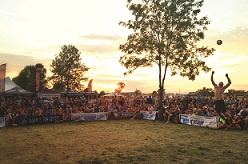
Outside of volleyball’s international governing body (Fédération Internationale de Volleyball, or FIVB and NGB, USA Volleyball, another group is essential to shaping and promoting the sport: the American Volleyball Coaches Association (AVCA).
Indoor: Still a powerhouse
According to the National Federation of State High School Associations’ 2012–2013 High School Athletics Participation Survey, indoor volleyball continues to be a strong choice for female athletes at the high school level. It ranks behind only basketball and track and field in the number of schools with programs.
Additionally, according to Sports and Fitness Industry Association (SFIA) statistics tracked by AVCA, overall five-year participation in the sport is up by over 15% for females from 2007–2012 and by over 3% for males.
Some tournaments have super-sized to keep up with the demand, which can place particular demands on event organizers.
“The biggest limiting factor for event operators is how many courts you have available,” says Kathy DeBoer, executive director of AVCA. “About 15 years ago, people began using convention centers. There are tournaments in different places around the U.S. that have 500–1,200 teams. There are portable courts and portable nets that are secured with weights and water barrels and everything else to keep the net tension high. There are volleyball courts as far as the eye can see. It’s like being inside a popcorn popper.”
Tom Pingel, senior director of indoor events and high performance for USA Volleyball has also noted the rise in convention center tournaments that require a minimum of 150,000 to 200,000 square feet and at least 300,000 square feet for national-level play.
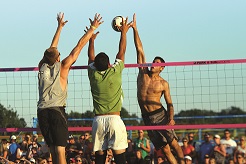
For national-level events, USA Volleyball looks not only at the facility, but at the bigger picture.
“For national events, obviously, the facility has to be large enough to accommodate us,” says Pingel. “It has to be a good location for hotels and affordable rates that are wiling to meet our terms, and also a destination that people from around the country are going to find to be cost effective and a good place to come. These people aren’t on expense accounts. For most people it’s a family vacation, so we move it around the country.”
Hosting the sport
The Raleigh Convention Center is home to the Mid-Atlantic Power League (MAPL) tournament, which brings in club teams from North Carolina and elsewhere on the eastern seaboard and is hosted by the Triangle Volleyball Club. Tori Collins is associate director of the Greater Raleigh Sports Alliance, which offers support to Triangle Volleyball Club’s efforts.
“It’s a great event for us every March,” says Collins. “Everyone is just so into it. It brings in about 4,000 people, so it’s kind of cool to see downtown just flooded with teenage volleyball players.”
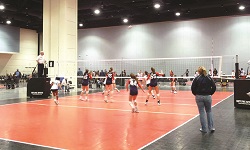
Plano, Texas, is investing in team sports and recreation with construction of three Plano Sports Authority complexes—PSA1 and PSA2 (already complete) and PSA-Murphy in the neighboring town of Murphy. Completion of PSA-Murphy is expected to bring the total number of volleyball courts to 31, and officials say there are good opportunities for sports event organizers who want to venture outside of major cities.
“With the addition of the third PSA, we will have nearly 250,000 square feet to offer for a tournament. We think that you get a lot more value out here. Our hotel rates are a little bit lower than Dallas and of course our venue rates are a little bit lower than Dallas,” says Cissy Aberg, sport sales manager for the Plano Convention and Visitors Bureau.
Conway, Arkansas, has had good success as an alternative to bigger cities when it comes to volleyball tournaments. From January to April of this year, Conway hosted eight weekend volleyball tournaments of two days each. The tournaments were held at the city’s Don Owen Complex and McGee Center, each of which has six volleyball courts.
Rachel Earls, director of destination marketing for the Conway Convention and Visitors Bureau sees the city’s size as a real asset.
“We are very easy to get to,” says Earls. “A lot of the towns that come are more rural, so I think it is attractive to them to come into a city the size of Conway.”

Beach volleyball and sand volleyball are different terms for the same sport. In some contexts, sand is the preferred term to underscore the fact that ‘beach’ volleyball can be played anywhere a sand court is built—no actual beach is necessary. Whatever term you use, the sport is growing at an impressive pace at the college level.
“We are growing on average 15 programs a year,” says DeBoer. “It sounds like a small number, but it is actually warp speed for colleges to be adding a varsity team.”
Pingel, while not directly involved with beach volleyball for USA Volleyball, projects that when the sport reaches NCAA championship status, the growth will only increase.
“I think we are going to see a rise in the number of clubs that are offering beach volleyball programs, so that is going to be a pretty hot property,” says Pingel.
According to SFIA statistics tracked by AVCA, overall five-year participation in the beach/sand volleyball arena is up by almost 45%. DeBoer theorizes that a number of factors account for this trend:
Sand courts are a relatively inexpensive facility to construct and they can be built almost anywhere.
- While indoor volleyball requires players who are exceptionally skilled in one area, sand volleyball—with only two players per team—is a great home for a generalist. This means that sand volleyball is absorbing many players who learn to play indoor volleyball in high school but who were previously excluded from the college level.
-
Interest in the sport is very high in the United States overall right now, following the success of Olympians such as Misty May-Treanor and Kerri Walsh Jennings.
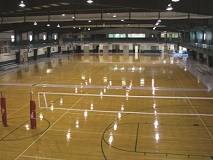
“With athletes, friends, family and spectators, the AVCA championships brought in $210,379 of direct visitor spending. That is over 600 room nights for the area,” says Michelle Russ, sports and events sales manager for the Gulf Shores and Orange Beach Sports Commission. “And AVCA is really one of those events that’s a signature event for our area, and the television coverage and the marketing and exposure are really phenomenal.”
Grass
If beach volleyball requires very little in terms of facilities infrastructure, grass volleyball requires even less. If you have grassy fields, you are good to go.
“With a grass field, you can go anywhere, you can play anywhere,” says Waupaca Boatride Volleyball Tournament founder Tom Galecke. “Basically, the boundaries are unlimited in terms of what you can do.”
It may be this flexibility that has made the sport equally flexible in the players it attracts.
The tournament, located in Oshkosh, Wisconsin, has a juniors divisions, with players as young as 10. Players who are in their 40s, 50s and 60s also attend the tournament and it is common to see multiple family members, if not entire families, playing in various divisions. This year, the tournament added a special skills clinic for junior players, featuring Olympic medalist Misty May Treanor.
Galecke credits the overall growth of Waupaca Boatride Volleyball Tournament to a few key decisions. One was the structure of competition.
“Volleyball is much more a participant sport than a spectator sport,” he says. “What we mean by that is that people love to play it.”
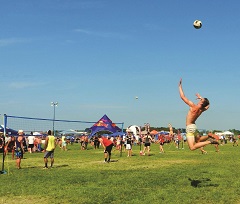
Another successful format change was the addition of on-site camping for the duration of the tournament. In addition to encouraging individuals to stay on-property instead of driving home at the end of each day, the experience of camping with other volleyball enthusiasts has served to forge a community of people who come back year after year.
Sitting
Sitting volleyball is indoor volleyball that is played from a seated position. It became a competition sport in the Paralympic Games in 1980. The game is largely the same as for able-bodied athletes, but with some adaptations. Players are to keep contact with the floor in a seated position at all times when handling the ball. The net height is lower than for play while standing. U.S. Paralympics, a division of the U.S. Olympic Committee, fosters the growth of Paralympic sports in the United States by working with athletes and organizations.
Team USA took the silver medal in women’s sitting volleyball at the 2012 Paralympic Games in London.
At the recreational to championship level, inside or outside, on sand, grass or solid flooring, played by able-bodied athletes or those with physical impairments, volleyball continues to win new enthusiasts. Look for the sport to continue its trajectory of growth in years to come.

